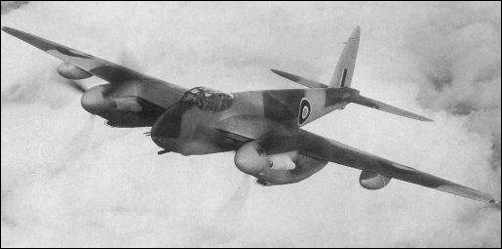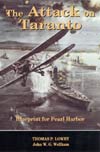Fighting the U-boats
Aircraft & Air forces
de Havilland Mosquito
prepared by Emmanuel Gustin

A Mosquito B Mk.IV
The de Havilland Mosquito was one of the most successful aircraft of the Second World War. Only the Junkers Ju 88 could rival its versatily. All this was achieved by an aircraft which encountered great resistance when it was offered to the RAF.
The Mosquito was designed as an unarmed, high-speed bomber. By dispensing with defensive armament the size, weight and drag of the aircraft could be greatly reduced. It was assumed that the resulting small, fast aircraft bomber would be almost impossible to intercept. The de Havilland design team lead by R.E. Bishop, R.M. Clarkson and C.T. Wilkins proposed the design of a twin-engined bomber, able to carry 1000 pounds (454kg) of bombs over 2400km, and able to reach a speed of 655km/h. The staff officers of the RAF and the officials of the Air Ministry where highly skeptic. They had earlier seen how some "fast" bombers had fallen short of the promised performance, or had been overtaken by progress in fighter designs, and became highly vulnerable. Also, de Havilland proposed a wooden construction, which is generally heavier than a metal one, but could be given a very smooth finish. However, a wooden structure was certain to deteriorate in a tropical climate, an important consideration for the RAF.
The project proceeded hesitantly, and would probably have been cancelled definitively without the support of Sir Patrick Hennesy. Finally, a small series was ordered, as reconnaissance aircraft. The prototype was built in great secrecy in Salisbury Hall, and made its first flight on 25 November 1940. The D.H.98 handled well and reached 632 km/h, faster than the fighters in production.
The Mosquito was a exceptionally streamlined design. The fuselage was made in left and right halves, which were shaped in concrete rigs and then joined. They were made of balsa wood between two layers of cedar plywood. The rest of the airframe was primarily made of spruce, with plywood covering. The wing was built in one piece, and attached to the lower side of the fuselage structure. The bomb bay was below it. The Merlin engines were put in steel-tube mountings in underwing nacelles, which also contained the main landing gear. The radiators were housed in the extended leading edges of the wing center section, with inlets in the leading edge and outlets under the wing. This was an arrangement which reduced drag and even contributed positive thrust. The cockpit, over the wing leading edge, had seats for the pilot and the navigator. The bomber and reconnaissance models had a transparent nose.

A Mosquito FB Mk.XVIII.
The barrel of the 57mm cannon is
clearly visible.
External fuel tanks are fitted under the wing.
The first production version was the PR Mk.I reconnaissance aircraft, powered by Merlin 21s, which arrived in the summer of 1941. Only a few of these were built, before production was switched to the B.IV bomber. The first Mk.IVs were converted Mk.Is, but from November 1941 on wards the production B.IVs arrived. Originally they carried four 250 lb bombs, but later a switch was made to four 500lb bombs with shortened tail fins. The PR.IV was a reconnaissance conversion of the B.IV. The T.III trainer appeared in early 1942, but was built in relatively small numbers.
From the start, high priority was allocated to a heavy fighter version, and the initial contract was amended so that half the order became fighters. They emerged as NF.II night fighters, with four 20mm cannon, four .303 machine guns, and AI Mk.IV radar. The NF.II became operational in May 1942, somewhat delayed by a shortage of Merlin engines and the end of the German night bomber offensive. Later night fighter models had centimetric AI Mk.VIII or Mk.X radar. The installation of the radar dish in the nose required the deletion of the machine guns.
In June 1942 the FB.VI fighter-bomber model flew, and this was to become the most built Mosquito. It had the four .303 guns and four 20mm cannon of the night fighter, but could also carry two 500lb bombs internally , and from 1944 on wards they were equipped to carry four rockets or a 500lb bomb under each wing. A variation was the FB.XVIII, sometimes called "Tse Tse", in which the four 20mm cannon were replaced by a single 57mm Molins cannon, which weighed 715kg and fired 6lb shells. Only two .303 guns retained, and additional armour was installed. These were originally intended as anti-tank aircraft, but because the 57mm cannon was obsolete in this role they were directed to Coastal Command.
The high-altitude performance of all models was greatly increased by the installation of Merlins with two-stage compressors, as installed in the PR.VIII, B.IX, or NF.XXX. The B.XVI introduced further refinement, with 'handed' engines to eliminate torque, and a pressure cabin. Some were fitted with bulged bomb bay doors, and could carry a single 4000lb (1814kg) bomb.
The Mosquito soon made its mark in many roles. It became the standard night fighter of the RAF, replacing the slower Beaufighter. They defended Britain against small numbers of German bombers, claimed 486 V-1s, escorted British bombers over Germany, and in "intruder" units they flew offensive missions at night. The bomber versions equipped the Pathfinder Force, marking targets for the heavy bombers of Bomber Command, and were used for light night attacks on German cities. Until the night fighter version of the Me 262 jet appeared (in small numbers) in 1945, the Germans did not have an effective defense. The fighter-bombers attacked precision targets throughout Europe with bombs and rockets. The long-range reconnaissance versions complemented the PR Spitfires. They were also used by the USAF, that assigned the designation F-8. Perhaps the most unusual version was the Sea Mosquito TR.33, a highly modified version which was designed for carrier operations -- a plan that was abandoned when the war ended.
Coastal Command had seven squadrons equipped with the FB.VI, and later also received the 27 FB.XVIIIs. The Mosquitos were used for anti-shipping strikes, mainly against coastal traffic. Because this brought them within the range of land-based Luftwaffe fighters, good performance was essential. But the coastal convoys were also well protected with anti-aircraft guns, and attacks were dangerous.
The Mosquito fights the U-boats
From November 1943 on wards the Mosquito was also used to attack U-boats shortly after, or just before they entered a port. Warning of these opportunities was provided by code breakers. At that moment the U-boats travelled on the surface, and therefore were vulnerable to rockets or the 57mm shells of the FB.XVIII. For safety, the U-boats usually formed small convoys, with an escort of mine sweepers or so called Sperrbrecher ships, which had hulls reinforced with concrete as a protection against mines; both types bristled with anti-aircraft guns. For example, on 27 March 1944 six FB.VIs and two FB.XVIIIs attacked a convoy towards La Pallice, formed by U-960 with a escort of four M-class mine sweepers and two Sprerrbrecher vessels. Three mine sweepers suffered light damage, U-960 was badly damaged, two Mosquitos returned home with serious damage, and one crash-landed.
Total production of the Mosquito was 7781, including 1034 built in Canada and 212 built in Australia.
U-boats sunk by this aircraft type (Mosquito)
de Havilland Mosquito
| Version | B.IV | NF.II | FB Mk.VI | B.XVI |
|---|---|---|---|---|
| Function | bomber | nightfighter | fighter-bomber | bomber |
| Engines | Two 1250hp Merlin XXI | Two 1460kW Merlin XXIII | Two 1250hp Merlin XXI | Two 1680hp Merlin 72 |
| Wing span | 16.51m | 16.51m | 16.51m | 16.51m |
| Length | 12.43m | 12.43 | 12.47m | 13.56m |
| Height | 4.65m | 4.65m | 4.65m | |
| Wing Area | 42.18m2 | 41.81m2 | 42.18m2 | |
| Empty weight | 5942kg | 6093kg | 6486kg | |
| Max. weight | 10152kg | 10115kg | 10433kg | |
| Max. speed | 612km/h at 5200m | 595km/h | 611km/h at 3960m | 656km/h |
| Ceiling | 9500m | 11000m | 11000m | |
| Range | 1960km | 2740km | 3033km | 2390km |
| Armament | 907kg | four Hispano-Suiza 20mm and four Browning .303 | 907kg, four Hispano-Suiza 20mm and four Browning .303 | 1814kg |
Sources
- Airplane Nr. 123
- Airplane Nr. 127
- Jane's All the World's Aircraft, 1945 (collector's edition).
- The TseTse and the U-boat, by Roy Nesbit, in Aeroplane Monthly, May/June 1991.
|
Books dealing with this subject include
|
Selected media links
|



